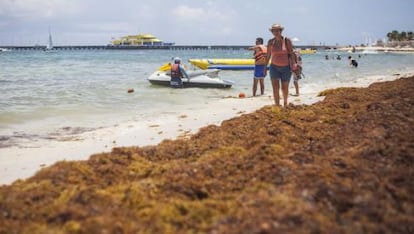Seaweed invasion threatening tourism on Mexico’s Caribbean coast
Changes in water conditions causing huge influx of gulfweed in popular vacation spots


It is 2pm and temperatures are rising in Playa del Carmen, one of the most popular tourist destinations on the Riviera Maya, situated 70 kilometers from Cancún. The staff of a beach-side hotel are preparing a paella under a huge Spanish flag while loudspeakers blare out music. About 20 guests are enjoying the party but the beach is deserted in this area. A mantle of dark seaweed has covered part of the sand and a nauseating odor fills the air, as if there were a sewer nearby. The ocean has lost its turquoise color and seems to have mixed with the earth.
Rising temperatures and a lack of cleanup resources have turned the situation into a nightmare
A few months ago, hotel owners on the Mexican Caribbean coast were surprised by an invasion of gulfweed. Now, rising temperatures and a lack of clean-up resources have turned the situation into a nightmare for vacationers as this brownish-gray algae rots in the sand.
“The arrival of gulfweed is natural but unusual in such large quantities,” says José Luis Prieto Funes, a representative from the Mexican Ministry of Environment in Quintana Roo. “Every two or three years the deep-sea gulfweed arrives from the Sargasso Sea east of the United States or from the mouths of the Amazon and Orinoco rivers, but never in such abundant quantities.”
Prieto Funes says the El Niño weather cycle has led to increased water temperatures, winds and strong currents and may be the cause of the problem, which is also affecting beaches in Trinidad and Tobago, Saint Martin, Puerto Rico and Barbados.
“Algae are sensitive to temperatures and the changes in the water may be associated with an increase in gulfweed,” says Daniel León Álvarez, a researcher from the National Autonomous University of Mexico. “However, unless we know the causes behind the increase, we cannot come up with a plan to solve it.”
Does gulfweed pose a danger?
“Gulfweed is a natural phenomenon that causes no harm but, when there is too much of it and it is not removed from the sand, it can produce certain kinds of pollutants,” José Luis Prieto of the Mexican environment ministry says.
“The algae are terrestrial plants that grow naturally,” says Dr. Daniel León Álvarez. “Sometimes they form large banks under the surface and they also have an ecological function because these are where many other organisms find refuge and food. The problem begins when it rots, like any other decomposing material. That is why it must be removed.”
The Mexican government has launched an emergency program to reduce the harmful effects on the environment but the project has hit two obstacles: American reefs and the arrival of turtles to lay eggs on the coast. “The biodiversity is very fragile and the measures need to be very careful. We have allocated 15 million pesos ($886,000) for a manual cleanup of the protected areas and we are supporting municipalities and regional governments with 12 million pesos ($700,000) for machines. We are investing 65 million pesos ($3.8 million) more in new technologies and, along with other institutions, studying to determine the best techniques” to use.
“Tourists complain, saying they come to good hotels and they can’t believe they don’t have a tractor,” says Josué, a 35-year-old member of one of the three cleanup crews who were sweeping the sand on Playa del Carmen at around noon on Saturday. “The algae have been coming since December. Our waists hurt from picking them up. Every day we bury the seaweed” in holes dug in the sand. Josué works 12-hour shifts and makes $413 a month without medical insurance. His tools are broken and so is his spirit.
“Some of the excess gulfweed that comes to the coast is used to build dunes on the coast,” Prieto Funes says. “Some is also used as compost after being treated with chemical fertilizers and some of it is buried in eroded areas.”
Meanwhile, the plague is discouraging tourists from bathing in this one-time Mexican paradise. Although hotels have had a high number of bookings in August because vacation packages are sold months ahead, the sector fears a drop in profits in the long term.
Translation by Dyane Jean François
Tu suscripción se está usando en otro dispositivo
¿Quieres añadir otro usuario a tu suscripción?
Si continúas leyendo en este dispositivo, no se podrá leer en el otro.
FlechaTu suscripción se está usando en otro dispositivo y solo puedes acceder a EL PAÍS desde un dispositivo a la vez.
Si quieres compartir tu cuenta, cambia tu suscripción a la modalidad Premium, así podrás añadir otro usuario. Cada uno accederá con su propia cuenta de email, lo que os permitirá personalizar vuestra experiencia en EL PAÍS.
¿Tienes una suscripción de empresa? Accede aquí para contratar más cuentas.
En el caso de no saber quién está usando tu cuenta, te recomendamos cambiar tu contraseña aquí.
Si decides continuar compartiendo tu cuenta, este mensaje se mostrará en tu dispositivo y en el de la otra persona que está usando tu cuenta de forma indefinida, afectando a tu experiencia de lectura. Puedes consultar aquí los términos y condiciones de la suscripción digital.
Archived In
Últimas noticias
Half of Scotland is in the hands of 420 property owners
Reinhard Genzel, Nobel laureate in physics: ‘One-minute videos will never give you the truth’
Pinochet’s victims grapple with José Antonio Kast’s rise in Chile
From digital curfews to blocking apps: How technology experts protect their children online
Most viewed
- Pablo Escobar’s hippos: A serious environmental problem, 40 years on
- Reinhard Genzel, Nobel laureate in physics: ‘One-minute videos will never give you the truth’
- Why we lost the habit of sleeping in two segments and how that changed our sense of time
- Charles Dubouloz, mountaineering star, retires at 36 with a farewell tour inspired by Walter Bonatti
- The Florida Keys tourist paradise is besieged by immigration agents: ‘We’ve never seen anything like this’








































